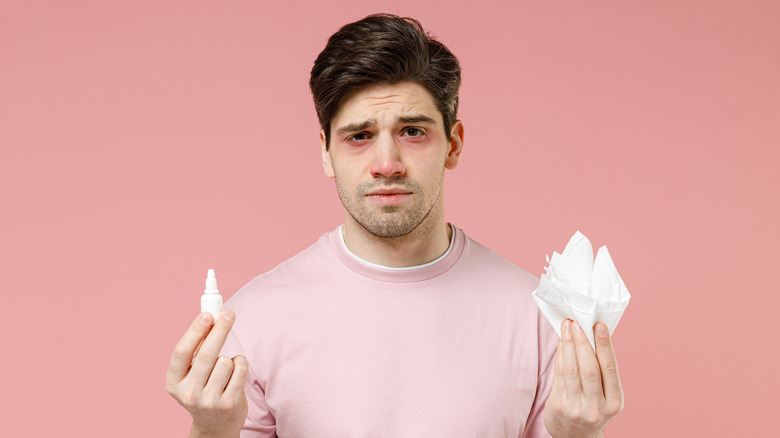Myths You Should Stop Believing About Allergies
Approximately 20% of the population has been diagnosed with at least one allergy (via the Allergy & Asthma Network). Allergies result from your body reacting to an object as dangerous when it's not. Your immune system creates antibodies against the entity. When you are exposed to the item again, the antibodies release substances that cause you to have an allergic reaction (per the Mayo Clinic).
The objects that cause allergies are known as allergens and come in several forms, including things you eat, breathe, touch, or get put into your body, according to the Asthma and Allergy Foundation of America (AAFA).
Between medical costs and the more than 4 million missed work days, environmental allergies cost Americans nearly $8 billion annually (via Allergy & Asthma Network). The JAMA Network gives a price tag of more than $25 billion yearly to food allergies. These costs go toward treating and managing the disease, as there is no cure (via the AAFA).
Allergic reactions present in several ways, including coughing, sneezing, runny nose, and scratchy throat. Other responses include hives and rashes. You could develop low blood pressure and trouble breathing if an allergic reaction is serious. If these issues are dealt with quickly, you could die, according to the AAFA.
Myth: If you have a food allergy, you can eat a small amount of the food
Food Allergy Research & Education (FARE) states that nearly 32 million Americans have food allergies. Approximately 90% of food allergies result from eggs, dairy products, nuts, fish, wheat, and soy. According to the American College of Allergy, Asthma & Immunology (ACAAI), the FDA will add sesame to the list in 2023.
Reactions vary from having an itchy, tingling mouth to anaphylaxis, wherein your throat swells closed, making it difficult for you to breathe (via the Mayo Clinic). Unfortunately, anaphylaxis often happens quickly and can be fatal. For that reason, most people diagnosed with a food allergy must carry a prescription epinephrine auto-injector at all times (via the ACAAI).
New Zealand Food Safety recommends that the best way to avoid a reaction to a known food allergen is to refrain from eating any amount of that food. Though easier said than done, completely removing the food from your diet is essential because everyone's body responds differently. How you react could depend on how much you consume and its preparation.
There is one exception to the avoidance rule, and that is known as Palforzia. Distributed by the company Aimmune Therapeutics, this FDA-approved peanut allergy treatment is given (by a healthcare provider) to children aged four to 17 and exposes them to increasing amounts of purified peanut protein. This prescription modifies the child's immune system and lowers their risk of severe reactions to accidental ingestion. However, this treatment does not cure or remove the allergy. Research into similar therapies for other food allergies is ongoing.
Myth: Food Allergies and intolerances are the same
Though many use the terms interchangeably, food allergies and intolerances are different (via Mid-Atlantic Permanente Medical Group). Food allergies result from your immune system reacting to an innocuous food. Food intolerances develop from a chemical reaction to something you ate or drank (via the Better Health Channel).
Medical professionals have difficulty diagnosing food intolerances due to the wide range of symptoms that result (from Healthline). However, some doctors find that eliminating and then slowly reintroducing foods helps to determine what triggers the reported symptoms. This is particularly true if they're gastrointestinal (via Alimentary Pharmacology and Therapeutics).
Food intolerance also stems from an enzyme deficiency, making it difficult for you to digest certain foods, according to Medical News Today. Symptoms of food intolerance are primarily stomach related and result in gas, pain, diarrhea, and nausea. Additionally, food intolerance symptoms arise over time and could last for days (per Medical News Today).
Many items cause food intolerance. The most common are dairy or lactose and gluten (via Healthline). Nearly 65% of people cannot digest dairy properly (via MedlinePlus).
Also referred to as non-celiac gluten sensitivity, an inability to tolerate the digestion of proteins found in wheat, barley, rye, and triticale is not to be confused with celiac disease. Celiac disease results from an autoimmune response. Though non-celiac gluten sensitivity is milder than celiac disease, the symptoms and treatment are similar. Your doctor can do testing to determine if you have either of these ailments (via Healthline).
Myth: Peanut is the most common food allergy
The ACAAI states that around 2.5% of children in the United States are allergic to peanuts, and a study by JAMA indicated that more than 4.5 million people have the allergy. The JAMA study puts peanuts at a close third on the list of reported allergies. Shellfish tops the list with close to 8 million people saying they have an allergy to foods in that category and milk comes in second at 4.7 million, and peanuts are the third cause of allergies.
Furthermore, an additional Clinical Reviews in Allergy and Immunology study shows that milk and egg allergies are more numerous than peanut allergies. The authors believe peanut allergies are more prominently discussed because they can cause anaphylaxis and be deadly.
Additionally, it's worth noting that the World Allergy Organization states that the number of children with peanut allergies (as of this writing) has doubled in 10 years.
Medical professionals recommend that babies with severe eczema or who have already been found to be allergic to eggs should be tested for a possible peanut allergy. If the test comes back positive, the doctor may recommend the child try a peanut product for the first time in the office. Regardless of the risk for the allergy, medical professionals recommend giving children peanut products shortly after introducing solid foods. Also, peanuts are not recommended for infants due to the choking hazard they present (via ACAAI)
Nearly 25% of children outgrow their allergy to peanuts (via Medical News Today).
Myth: All allergy-inducing ingredients must be listed on the label
According to the World Allergy Organization Journal, 66 countries worldwide have laws that require allergenic ingredients to be listed on prepackaged foods. The United States has the Food Allergy Labeling and Consumer Protection Act (FALCPA), and it was updated in 2021 through the passage of Food Allergy Safety, Treatment, Education and Research (FASTER).
First passed in 2004 by the FDA, these laws require packaged foods to have labels that are easy to understand and divulge the use of any "major food allergens," including milk, wheat, egg, peanuts, tree nuts, fish, crustacean shellfish, and soy. In 2020 the FDA issued a draft guidance "for voluntary sesame labeling to encourage manufacturers to clearly declare sesame in the ingredient list, when it is used as a 'flavoring' or 'spice' or when the common or usual name (such as tahini) does not specify sesame."
The FDA gives companies two ways to present the use of allergens. They can list it as part of the ingredient list in parenthesis next to the item that supplies it, or they can add a list of allergens under the bold heading "Contains" at the end of the ingredient list.
Confusion occurs when it comes to Precautionary allergen labeling (PAL), which is often listed as "May Contain" or "Produced in a factory which also processes." PAL warns those intending to purchase the product that there's a risk — though unintended — that allergens could be in the item. Because PAL is voluntary, there are no guidelines on how this information is to be included on the packaging (via Clinical & Experimental Allergy)
The FDA recommends always reading labels, even on previously purchased items, as the ingredient list can change.
Myth: Some dog breeds are ok if you're allergic
According to the American Pet Products Association (APPA), nearly 70 million households in the U.S. have a dog as a pet. This high number comes even though 10-20% of people have an allergy to pets with fur (via Allergy, Asthma & Immunology Research (AAIR).
With that said, those looking for a cuddly companion can look to dogs over cats, as cat allergies get diagnosed twice as frequently as those to their canine counterparts, and reactions to felines tend to be more extreme (per Healthline).
Additionally, there are several breeds that some consider hypoallergenic because they shed less than other breeds or don't shed at all (via Good Housekeeping). However, according to GoodRx, even dogs designated as allergy-friendly create allergens because the substance that triggers your response comes from their skin, saliva, and urine.
Furthermore, allergen levels fluctuate within and between breeds (per Journal of Toxicology and Environmental Health). A study published by The Journal of Allergy and Clinical Immunology found that the amount of dander, the substance responsible for an allergic reaction, regardless of whether the dog was considered hypoallergenic or not.
Studies cited by the International Journal of Hygiene and Environmental Health both support and refute the argument that early exposure to canines helps babies avoid allergies to animals and other environmental allergens.
Myth: There are places you can live to avoid allergies
The Asthma and Allergy Foundation of America (AAFA) looked at several factors, including pollen scores throughout the year, how many people used over-the-counter allergy medication, and how many board-certified allergists/immunologists a city had available. Using this information, they determined that for 2022, Scranton, Pennsylvania, is the worst place to live with allergies. However, before moving to the city considered the least challenging place to live with seasonal allergies, Seattle, Washington, there are factors for you to contemplate.
And the American Academy of Allergy, Asthma & Immunology (AAAAI) recommends that you test whether or not your allergies decrease by spending substantial time in the area you are considering to live. Pollen, mold, and grasses are different everywhere. Additionally, you could find another allergy in the new place while getting away from your original trigger.
Furthermore, not only can you develop allergies at any age, it can take up to three years of exposure to a particular pollen before you have allergy symptoms (via U.S. News & World Report).
The AAFA recommends you check the pollen count every day wherever you live. You should also limit your contact with pollen by staying inside as much as possible when the count is high — also, showering and washing your clothes after spending time outdoors can be helpful.
Myth: Hay fever is caused by hay
In 1819, Liverpool-born, London-based doctor John Bostock wrote a paper describing his symptoms that occurred every summer. His illness came to be known as hay fever because "it is produced by the effluvium (smell) from new hay" (via Weldricks Pharmacy)
However, according to the BBC, Bostock didn't agree that hay was the cause and believed his symptoms were exacerbated by "the exhausting heat of summer." He found relief by renting a clifftop house for three years.
It wasn't until 1859 that Charles Blackley's sneeze (caused by a bouquet of bluegrass) propelled him to find out the actual cause of his symptoms wasn't the substances created by hay. Instead, his discomfort resulted from grass pollen (via BBC).
Today, medical professionals generally refer to the cold-like symptoms associated with hay fever as allergic rhinitis and know it's caused by pollen, dust mites, and pet dander (via the Mayo Clinic).
The BBC reports that Bostock looked for nine years and only found 28 cases similar to his own. However, in 2018 the CDC said more than 19 million people had been diagnosed with allergic rhinitis or hay fever. Furthermore, Americans saw their doctors more than 7 million times that year, hoping to get some symptom relief.
Myth: Allergic reactions get worse with each exposure
In some cases, the first time you get introduced to an allergen, you experience only a mild reaction, which can take several exposures before it becomes serious. However, once you respond to a substance, regardless of the amount, you are susceptible to having other reactions (via MedlinePlus).
The nature of allergic reactions is unpredictable. In fact, you could have completely different symptoms when you are subsequently exposed to a known allergen. Your response depends on your allergy and exposure levels (per the National Academy of Sports Medicine).
Co-factors, including whether or not you have asthma, alcohol intake, and medications taken at the time of exposure, also impact the severity of your reaction (via Food Allergy Canada)
Furthermore, seasonal allergy reactions, like those associated with hay fever, tend to stay constant. However, an "anaphylactic reaction" can worsen with additional exposure to the known allergen (per the University of Nevada School of Medicine).
Food Allergy Canada reminds those with allergies that reactions vary in severity and should be taken seriously each time they occur.
Myth: Continuous exposure desensitizes you to what you are allergic to
Allergen immunotherapy through injection or sublingual administration can help desensitize you to an unavoidable allergen, including mold, pollen, dust mites, and insect venom. However, these treatments aren't always effective and could take more than five years to work (via Merck Manuals).
Allergy shots or subcutaneous immunotherapy are given by a doctor in the office weekly or bi-weekly. When provided for under-the-tongue use, you need to administer it yourself daily. Both methods are effective, and the approach used depends on personal and doctor preference. Allergen immunotherapy done by injection or sublingual helps prevent cross-reactive allergies from developing into asthma. However, when you stop either of these methods, symptoms could return worse than when they initially occurred (per Institute for Quality and Efficiency in Health Care).
Another form of allergen immunotherapy is oral administration (OIT). "Peanut, egg and milk OIT have been shown to desensitize approximately 60-80% of patients studied" (per the AAAAI).
According to Merck, OIT for peanut allergies is first administered under doctor supervision, as is any dose increase.
The AAAAI reminds you that there is no one-size-fits-all treatment for allergies.
Myth: Eliminating wheat and milk helps hay fever
According to the Mayo Clinic, many people confuse wheat allergies and celiac disease. While some symptoms overlap, a wheat allergy results from your body's antibody production in reaction to wheat proteins. Celiac disease is an "abnormal immune system" response to gluten.
While both problems can cause stomach issues, including nausea, cramps, and diarrhea, having an allergy to wheat can also result in symptoms similar to those caused by hay fever (per Mayo Clinic).
Additionally, the Journal of Asthma and Allergy discusses a condition known as baker's asthma — generally referred to as an occupational disease, baker's asthma results from significant repetitive exposure to wheat flour.
There is a long-held belief that milk increases mucous production (via Medical Hypotheses). Symptoms of increased phlegm are also connected to hay fever, according to the Australasian Society of Clinical Immunology and Allergy (ASCIA). These similarities may explain the connection between dairy and hay fever. "This is not because milk causes infection, but rather because children with food allergy are more likely to have allergic rhinitis and other allergies" (ASCIA).
However, according to the study published by Medical Hypotheses, there is limited medical evidence connecting the two. Your gut breaks down any dairy you consume, and it must pass through your circulatory system to affect any other part of your body.
Another study referenced by the Mayo Clinic found no symptom differences in asthmatic children regardless of the type of milk they drank. Researchers believe that the feeling left behind after consuming milk is similar to that of increased phlegm in the throat.
Myth: You can outgrow your allergies
According to the Mayo Clinic, up to 80% of children with milk or egg allergies no longer react to those foods by age 16. Additionally, reactions diminished for 20% of those with peanut allergies, 14% with tree nut allergies, and 5% of those allergic to either fish or shellfish.
When it comes to airborne allergies, medical professionals have yet to identify how one develops a tolerance to a substance that previously gave them problems. The doctors at Asthma & Allergy Associates, P.C., think it could simply be a change in symptoms from season to season. It could also be that the particular type of pollen you're allergic to is not present in your current environment.
Another factor to consider is a study published by the American Academy of Pediatrics that shows an almost four percentage point difference between those thought to have an allergy and those diagnosed by a doctor.
While testing is being conducted, researchers have yet to develop a way to expedite the process of enabling your body to tolerate what it currently reacts to (via The Ohio State University Wexner Medical Center).
It's best to speak with your doctor and get tested if you think you've outgrown a particular allergy (per the Cleveland Clinic)
Myth: Allergies are psychosomatic
According to South African allergist Dr. Adrian Morris, "The mind can play a role in exacerbating allergic reactions" (via News24). A 2019 study published by JAMA shows that nearly half of those who said they had allergies tested negative. However, most doctors do skin testing to properly diagnose you with an allergy. A tiny drop of the suspected allergen is placed on your skin, and a reaction determines your sensitivity (via the AAFA). One reason JAMA gives (for the discrepancy) is that people misinterpret the symptoms of intolerance or sensitivity to that of an allergy.
Furthermore, Harvard researcher Dr. Ahmad Sedaghat reported stress could make allergy symptoms seem worse than they are, and stress' effect on your adrenal glands also causes a physical response that can cause allergy symptoms to worsen.
Additionally, BMJ Open published a study that demonstrated a correlation between eczema, asthma, and hay fever to anxiety and depression. Children with these illnesses are more likely to have psychological and social impairments.
Finally, Brain, Behavior, and Immunity authors were able to find a connection between depression and inflammation.
Myth: Local honey helps cure allergies
Bees make honey after they collect and eat pollen and nectar from flowers. However, the collected pollen isn't the same as the ones responsible for human allergies. Furthermore, even if the pollens were the same, because enzymes in both the bee's stomach and your stomach break down the pollen, you couldn't ingest enough to improve your allergy symptoms (via AAFA).
Furthermore, the University of Connecticut Health Center's Lowell P. Weicker General Clinical Research Center printed a study in Annals of Allergy, Asthma & Immunology, where they analyzed three groups. One group was given local unpasteurized honey, the second group was assigned national pasteurized honey, and a third group had a placebo of corn syrup. No group experienced symptom relief.
However, the participants in a study printed in the Annals of Saudi Medicine not only showed symptom improvement, but the changes remained a month after the study ended. One reason for this discrepancy may be that many researchers examine honey as a cough suppressant due to its anti-inflammatory effects (per the Mayo Clinic).
Doctors at the Mayo Clinic remind you that if you try honey to help with your child's symptoms, don't give honey to anyone under one year as you risk infant botulism, a severe but rare form of food poisoning.
Myth: You can't tell colds and allergies apart
Colds and allergies share similar symptoms. However, their causes and duration vary (via Medical News Today).
Allergies result from your immune system reacting to an innocuous substance causing your body to create histamine that results in issues with your sinuses, lungs, and skin. Cold symptoms result from your body trying to fight off a contagious virus that entered your body through your eyes, nose, or mouth (per GoodRx).
The color of the mucus your body produces helps you determine whether you have a cold or allergies. If the snot from your nose is clear, that's a good indication of allergies. However, if it's yellow or green, it's a sign your body is fighting an infection (via OSF Healthcare System).
Furthermore, if you have a cold, you are more likely to have a sore throat and body aches, while those with allergies experience itchiness in and around their face. Additionally, while most colds last between seven to 10 days, allergies will remain as long as whatever triggers them remains present. Finally, what triggers your symptoms is also an indication of whether you have a cold or allergies. If you are around someone sick and then feel ill yourself, it's more than likely a cold. However, if you're in an area with high pollen counts, it's more likely to be allergies (via GoodRx).
If your symptoms become severe or last longer than two weeks, seek medical attention, according to Medical News Today.















